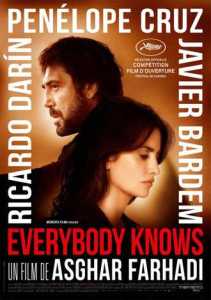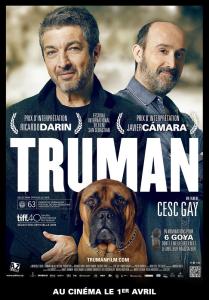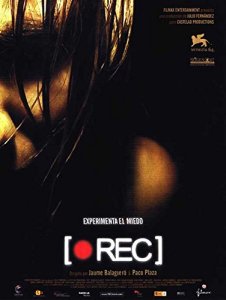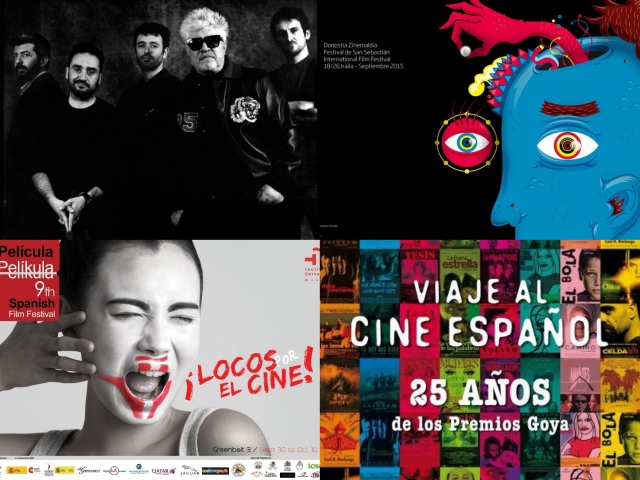Spain has always had a reputation of good quality cinema. During its long story, it was the great filmmaker Luis Buñuel who first achieved universal recognition, when together with Salvador Dalí made the surrealistic Un Chien Andalou in 1928. However, due to the nation’s political isolation, Spain did not participate in the European cinema new waves, and remained mostly inconspicuous.
The “new cinema” of the ‘60s produced some great films, but only after Franco’s death in 1975, Spanish cinema gained renewed international recognition, led particularly by its “terrible child” Pedro Almodóvar. Since then, a whole generation of filmmakers has grown-up and kept producing interesting work, and many other talented, cine-literate artists have emerged.
For this list I picked 15 great Spanish films of the 21st century, which put in evidence the talent of Spain’s contemporary filmmakers; for the sake of variety I chose only one film per director. Enjoy them, and let me know which one is your favourite!
1. TODOS LOS SABEN (EVERYBODY KNOWS), 2018
 The plot: A Spanish woman living in Buenos Aires returns to her hometown to assist to her sister’s wedding. Unexpected events, though, will upset the wedding and bring deeply buried family secrets to the surface.
The plot: A Spanish woman living in Buenos Aires returns to her hometown to assist to her sister’s wedding. Unexpected events, though, will upset the wedding and bring deeply buried family secrets to the surface.
Go see it, because… This is another great film by the Iranian director Asghar Farhadi, who reunites this time an outstanding cast: Penélope Cruz, Javier Bardem and Ricardo Darín, among others. Everybody Knows provides an emotional and thought-provoking journey into a small Spanish community, evokes several contemporary dilemmas, and leaves the morality of the story open to the viewer’s judgement.
2. CONTRATIEMPO (THE INVISIBLE GUEST), 2016
 The plot: A young businessman wakes up in a hotel room next to the body of his dead lover. He hires a prestigious lawyer to defend him, and over the course of one night, they work together to find out what happened.
The plot: A young businessman wakes up in a hotel room next to the body of his dead lover. He hires a prestigious lawyer to defend him, and over the course of one night, they work together to find out what happened.
Go see it, because… It is an awesome thriller with great acting and pacing, masterfully directed and exquisitely written by Catalán Oriol Paulo. Tense and suspenseful, it is certain the plot twist at the end will leave completely shocked!
3. TRUMAN, 2015
 The plot: Julián, a theater actor, has had cancer for a year, and his only companion is his dog Truman. When he receives an unexpected visit from his friend Tomás who lives in Canada, the two men, together with Truman, will share emotional and surprising moments trying to cope with Julián’s complicated situation.
The plot: Julián, a theater actor, has had cancer for a year, and his only companion is his dog Truman. When he receives an unexpected visit from his friend Tomás who lives in Canada, the two men, together with Truman, will share emotional and surprising moments trying to cope with Julián’s complicated situation.
Go see it, because… Directed and written by Cesc Gay, with the adequate dose of honesty and realism, Truman is a moving, sweet and sour, well-acted comedy/drama about grief, friendship, love and family. Cámara and Darín are superb in their roles, providing effortless, emotional depth to their characters.
4. 8 APELLIDOS VASCOS (SPANISH AFFAIR), 2014
 The plot: Rafa is a Sevilian who has never left his native Andalucía, until he meets a Basque girl named Amaia and decides to follow her to the Basque Country. A series of misunderstandings forces Rafa to impersonate a full-blooded Basque with eight Basque surnames, getting more and more entangled in that character in order to please Amaia.
The plot: Rafa is a Sevilian who has never left his native Andalucía, until he meets a Basque girl named Amaia and decides to follow her to the Basque Country. A series of misunderstandings forces Rafa to impersonate a full-blooded Basque with eight Basque surnames, getting more and more entangled in that character in order to please Amaia.
Go see it, because… Emilio Martínez Lázaro’s romantic comedy was a box-office phenomenon in Spain, becoming the highest-grossing Spanish film of all time! Besides its solid script and amusing characters, the film’s huge success is arguably due to the way it deals with the different stereotypes and preconceptions among the different Spanish regions, a subject always relevant to the country. People who are not familiar with Spanish local traditions, accent and politics may miss some of the gags, but everybody will enjoy most of the hilarious situations, and the beautiful scenery of País Vasco (Basque Country) and Andalucía (Andalusia).
5. LA ISLA MÍNIMA (MARSHLAND), 2014
 The plot: In 1980, two Madrid homicide detectives are sent to the Guadalquivir Marshes in Spain’s ‘Deep South’ to investigate the disappearance of two teenage sisters during the town’s festivities. Both detectives must settle their ideological differences and bring the murderer to justice before more young women lose their lives.
The plot: In 1980, two Madrid homicide detectives are sent to the Guadalquivir Marshes in Spain’s ‘Deep South’ to investigate the disappearance of two teenage sisters during the town’s festivities. Both detectives must settle their ideological differences and bring the murderer to justice before more young women lose their lives.
Go see it, because… It is a hypnotic, multi-layered thriller, masterfully directed by the talented Alberto Rodríguez, with breathtaking photography and superb acting. A careful character-study, which also introduces some political undertones during a turbulent period of the Spanish history. The film received 10 Goya awards (Spain’s main national annual film awards), among many other prizes and nominations.
6. TAMBIÉN LA LLUVIA (EVEN THE RAIN), 2010
 The plot: As a director and his crew shoot a controversial film about Christopher Columbus in Bolivia, local natives rise up against the privatisation of their water supply. The production is beset by more and more problems and the riots escalate, raising the tension between the crew members and leading them to a moral crisis.
The plot: As a director and his crew shoot a controversial film about Christopher Columbus in Bolivia, local natives rise up against the privatisation of their water supply. The production is beset by more and more problems and the riots escalate, raising the tension between the crew members and leading them to a moral crisis.
Go see it, because… Written by Paul Laverty (Ken Loach’s regular collaborator) and skilfully directed by Icíar Bollaín (who is also a well-known Spanish actress), the film examines a social and political event that took place in Cochabamba, Bolivia in the year 2000, known as the Water War. Featuring an excellent cast, which includes the Mexican actor Gabriel García Bernal, the film parallels indigenous resistance 500 years ago and nowadays, managing not only to teach us without dogmatism and bias, but also to be moving and entertaining.
7. CELDA 211 (CELL 211), 2009
 The plot: Juan Oliver reports to his new work as a prison officer one day earlier to make a good impression, leaving at home his pregnant wife Elena. During his tour of the prison though, a riot in the High Security zone begins, leaving him trapped inside Cell 211. Juan must then pretend to be another inmate in order to guarantee his own safety, while trying to draw a plan to get him out of the prison. The situation escalates though, and unexpected shifts occur, both within and outside the prison.
The plot: Juan Oliver reports to his new work as a prison officer one day earlier to make a good impression, leaving at home his pregnant wife Elena. During his tour of the prison though, a riot in the High Security zone begins, leaving him trapped inside Cell 211. Juan must then pretend to be another inmate in order to guarantee his own safety, while trying to draw a plan to get him out of the prison. The situation escalates though, and unexpected shifts occur, both within and outside the prison.
Go see it, because… It is a raw, enthralling thriller, with great plot and character development, and edge-of-the-seat suspense. Excellent direction by Daniel Monzón and top-notch acting add up to make Celda 211 a memorable film. It was an artistic and commercial success; it received 43 awards (including 8 Goya Awards) and 24 other nominations.
8. [REC], 2007
 The plot: Late-night TV reporter Angela and her cameraman are following the night shift of Barcelona’s fire station. When they receive a call from an old lady trapped in her apartment, journalists and firemen remain confined inside the perilous building. A terrible nightmare ensues, which is thoroughly recorded by the TV crew.
The plot: Late-night TV reporter Angela and her cameraman are following the night shift of Barcelona’s fire station. When they receive a call from an old lady trapped in her apartment, journalists and firemen remain confined inside the perilous building. A terrible nightmare ensues, which is thoroughly recorded by the TV crew.
Go see it because… It is a superb horror film, among the scariest I have seen lately, but also a dark satire of the mass media. It may remind us The Blair Witch project; nevertheless, it is quite fresh and original in its plot development and ending. Co-directed by Jaume Balagueró and Paco Plaza, the film was so successful that inspired an American remake, Quarantine and three sequels, [REC]2, [REC]3 and [REC]4.
9. EL ORFANATO (THE ORPHANAGE), 2007
 The plot: A woman brings her family back to her childhood home, which used to be an orphanage. Before long, her son disappears, and is later presumed dead. Grief-stricken Laura believes she hears spirits, who may be trying to help her find the boy.
The plot: A woman brings her family back to her childhood home, which used to be an orphanage. Before long, her son disappears, and is later presumed dead. Grief-stricken Laura believes she hears spirits, who may be trying to help her find the boy.
Go see it, because… It is a scary, creepy, thrilling and suspenseful film, but also a moving and intelligent one, wonderfully acted by Belén Rueda and carefully directed by Juan Antonio Bayona. It was critically acclaimed and received multiple national and international awards, including 7 Premios Goya.
10. EL LABERINTO DEL FAUNO (PAN’S LABYRINTH), 2006
 The plot: In the falangist Spain of 1944, a young girl fascinated by fairy-tales is sent to live with her stepfather, a captain of the Spanish army. As the girl witnesses her stepfather’s sadistic brutality, she is drawn into Pan’s Labyrinth, a magical world of mythical beings.
The plot: In the falangist Spain of 1944, a young girl fascinated by fairy-tales is sent to live with her stepfather, a captain of the Spanish army. As the girl witnesses her stepfather’s sadistic brutality, she is drawn into Pan’s Labyrinth, a magical world of mythical beings.
Go see it, because… This is one of the most critically acclaimed films of Spain’s contemporary cinema, directed by Mexican-born Guillermo del Toro. It won 99 awards, including 3 Oscars; it is on IMDB’s best films of all time list (#129), with a Metascore of 98! Of course, all of them deserved: El laberinto del fauno is indeed a beautiful, magical, dark fairy tale, a brilliant and timeless masterpiece.
11. MAR ADENTRO (THE SEA INSIDE), 2004
 The plot: The true story of former sailor and writer Ramón Sampedro, who was quadriplegic for almost thirty years and fought in court in favor of euthanasia and his own right to die. Despite his wish to die, he taught everyone he encountered the meaning, value and preciousness of life.
The plot: The true story of former sailor and writer Ramón Sampedro, who was quadriplegic for almost thirty years and fought in court in favor of euthanasia and his own right to die. Despite his wish to die, he taught everyone he encountered the meaning, value and preciousness of life.
Go see it, because…Young director Alejandro Amenábar had already displayed his talent before in the films Tesis, Abre los ojos (Open your eyes) and The Others. With this movie, though, not only he established himself as one of the best Spanish directors of his generation – he also wrote, edited and scored the film – but also managed to tackle an extremely delicate subject with utmost dexterity and sensibility. Not to mention the exceptional cast –Javier Bardem, Belén Rueda, Lola Dueñas- which adds up to make this film a beautiful and unforgettable piece of art. Mar adentro won the Oscar for Best Foreign Language film, as well as many other national and international awards.
12. HABLE CON ELLA (TALK TO HER), 2002
 The plot: After a chance encounter at a theater, Benigno and Marco meet at the private clinic where Benigno works. Marco’s girlfriend is a bullfighter who has been gored and is in a coma. Benigno is looking after Alicia, a young ballet student who is also in a coma. The lives of the four characters will intertwine, dragging them towards an unsuspected destiny.
The plot: After a chance encounter at a theater, Benigno and Marco meet at the private clinic where Benigno works. Marco’s girlfriend is a bullfighter who has been gored and is in a coma. Benigno is looking after Alicia, a young ballet student who is also in a coma. The lives of the four characters will intertwine, dragging them towards an unsuspected destiny.
Go see, it because… Pedro Almodóvar is arguably Spain’s most iconic filmmaker; his particular style, although irreverent, sarcastic and witty, always manages to dig deeply into the human soul. Hable con Ella is regarded as Almodovar’s greatest film: it is a very profound and multi-layered film about love, friendship and existence. Brilliant, disturbing and thought-provoking… Hable con ella was internationally acclaimed, obtaining many international awards such as Oscar, Golden Globe, BAFTA, Cesar, among others.
13. LOS LUNES AL SOL (MONDAYS IN THE SUN), 2002
 The plot: A group of men left jobless by the closure of the shipyards in Vigo, Galicia bide their time together in the local pub, opened and run by one of their former coworkers. The group is held together by the affable Santa, who is the de facto leader and sometimes father-confessor.
The plot: A group of men left jobless by the closure of the shipyards in Vigo, Galicia bide their time together in the local pub, opened and run by one of their former coworkers. The group is held together by the affable Santa, who is the de facto leader and sometimes father-confessor.
Go see, it because… Director Fernando León de Aranoa deserves credits for capturing the feeling of the unemployed with no family, possession or future in such a poignant and realistic manner, without becoming dull or boring. Besides its impeccable direction, the film delivers a really intelligent – and relevant – script, and outstanding acting by two among Spain’s best: Javier Bardem and Luis Tosar.
14. LA COMUNIDAD (COMMON WEALTH), 2000
 The plot: A real state agent accidentally discovers a treasure hidden in the apartment of a deceased man. She is determined to escape with the loot, but the rest of the building’s tenants think otherwise…
The plot: A real state agent accidentally discovers a treasure hidden in the apartment of a deceased man. She is determined to escape with the loot, but the rest of the building’s tenants think otherwise…
Go see, it because… Alex De La Iglesia is well known for his dark comedies – his 1995 El día de la Bestia (The day of the Beast) catapulted him into fame – and this film is no exception: it is a terrific dark tale that brings out the darkest side of human nature. No need to show devils, zombies, or evil spirits: nothing is scariest than the guy next door! The film is creepy, suspenseful and crazily funny; the characters – led by the great Carmen Maura- are all memorable.
15. EL BOLA, 2000
 The plot: El Bola (“the Pellet”) is a 12-year-old boy emotionally and physically damaged by the constant abuse of his father. The arrival of a new boy at school exposes him to the true meaning of friendship and family.
The plot: El Bola (“the Pellet”) is a 12-year-old boy emotionally and physically damaged by the constant abuse of his father. The arrival of a new boy at school exposes him to the true meaning of friendship and family.
Go see, it because… The film deals with a very relevant issue, that of child beating, which is displayed with great realism – although keeping violence to a strict minimum, pertinent to the story-telling – and deep characters, who avoid exaggerating the crude and difficult situations enacted. Remarkable cast, excellent direction by Achero Mañas, who won 4 Goya awards with this film, including best film and best new director.
Do you agree with this list? Let me know of other, great Spanish Films!























 hot.
hot. There are 13 towns spreading across the Amalfi Coast, all with their unique beauty and charm. Visit them all if you have the time! But the undisputed “star” of the Coast is definitely picture-perfect Positano, a former fishing village that has become a first-class tourist destination.
There are 13 towns spreading across the Amalfi Coast, all with their unique beauty and charm. Visit them all if you have the time! But the undisputed “star” of the Coast is definitely picture-perfect Positano, a former fishing village that has become a first-class tourist destination. You don’t get enough when walking along the picturesque roads. Therefore, Positano certainly deserves a whole day to discover.
You don’t get enough when walking along the picturesque roads. Therefore, Positano certainly deserves a whole day to discover.




























